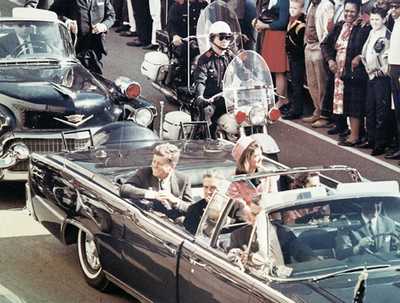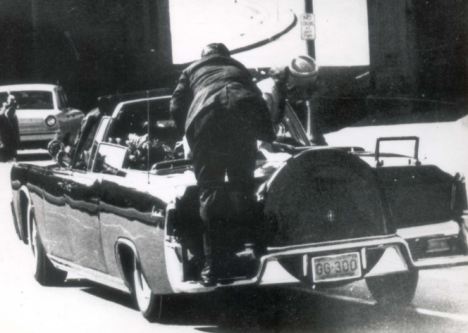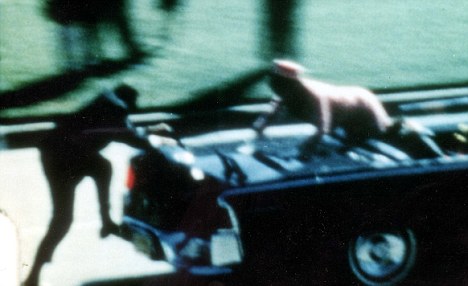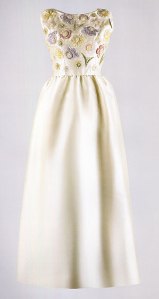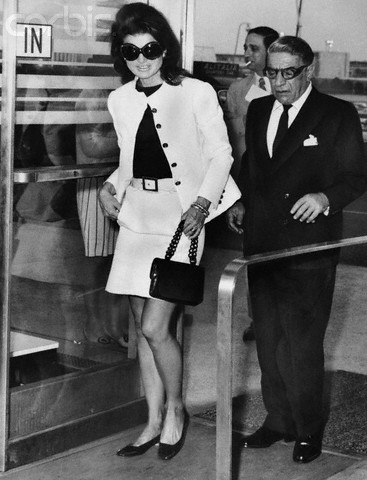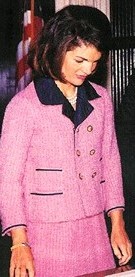
Jackie Kennedy wears the famous pink suit in this 1962 photo. She is looking at plans for Lafayette Square.
President John F. Kennedy looked out the window of his Fort Worth, Texas, hotel suite. The November sky was dark and threatening. It looked like rain. Forecasters predicted cool weather. The president advised his wife Jackie to dress warmly for the long and demanding day and personally selected her oufit. He chose a pink wool suit with three-quarter-length sleeves and a blue underblouse. To it, Jackie added a pink pillbox hat and white gloves.
Jackie, 34, had worn the suit before – she called its color “raspberry” – and it was one of the president’s favorites. He had told mutual friend Susan Mary Alsop that Jackie, his wife of ten years, looked “ravishing in it.” (1)

President and Mrs. Kennedy at the White House, October 1962. Jackie Kennedy is wearing the pink wool Chez Ninon she wore in Dallas, November 22, 1963
Jacqueline Kennedy‘s pink suit was made in 1961 by the New York dress salon, Chez Ninon. It was a copy of a Chanel pink boucle wool suit trimmed with a navy blue collar. (1)
Jackie Kennedy was a style icon. People noticed what she wore. Kennedy critics were quick to pounce when Jackie wore Paris fashions. Jack urged his wife to buy American and she did. Such a move was both financially and politically savvy. The Chez Ninon knockoff cost between $800 and $1,000 compared to over $10,000 for a custom-made Chanel suit. Plus, he and Jackie were in Texas with Vice President Lyndon Johnson and wife Lady Bird to officially kick off their 1964 presidential campaign. They had to minimize the fallout from Jackie’s expensive French taste.
Jackie’s pink suit was a hit at the Fort Worth breakfast that morning. The president beamed at the attention she drew, noting that “nobody notices what Lyndon and I wear.” A short plane ride later, they were disembarking at Dallas Love Field to a promising reception. Jackie was presented red roses.

President John F. Kennedy and First Lady Jackie Kennedy arrive at Love Field in Dallas, Texas, on November 22, 1963.
The sun had come out and the day had become unseasonably warm. The Kennedys climbed into the back seat of the presidential limousine to begin the winding 11-mile route through downtown Dallas where the president was to speak at a Trade Mart luncheon. Texas Governor John Connally and wife Nellie got into the jumpseat in front of the Kennedys and behind the driver and two Secret Service agents.
The presidential limo was a midnight blue 1961 Lincoln that had been flown in from Washington, D.C. Because the weather was so nice, the plastic bubble top had been removed and the bullet-proof side windows were rolled down. This is how President Kennedy preferred to ride. At 11:50 a.m., the 12-car motorcade with its motorcycle escort and Secret Service attendants left the airport “on its rendevous with fate.” It was November 22, 1963. (2)
The crowds lined the parade route so thickly that the motorcade moved at a crawl of only 6-7 miles an hour. The president clearly loved the warm Texas welcome, smiling and waving at all the friendly faces.

JFK and Jackie ride in the presidential limo through the streets of Dallas, November 22, 1963. Texas Governor John Connally sits up front.
The temperature was 76 degrees. The sun was blindingly hot. Jackie was wearing wool. She shielded her eyes from the big Texas sun with her trademark sunglasses.
The people shouted, “Jack, Jackie!” recalled Nellie Connally. “They seemed to want her as much as they wanted him.” She could hear Jack say to Jackie,” Take your glasses off….When you’re riding in a car like this, in a parade, if you have your dark glasses on, you might as well have stayed at home.”
Nellie Connally smiled to know that Texans were treating their president with such courtesy. She turned to him and said,
Mr. President, you can’t say that Dallas doesn’t love you.” (3)
Thirty seconds later, at 12:30 p.m., three shots rang out. The 35th President of the United States was shot. As the car sped toward Parkland Hospital, Kennedy slumped in his wife’s lap, his blood and brain fragments staining her pink wool suit, gloves, stockings. Jackie crawled out the back of the limo for help from the Secret Service riding in the car behind them.

In an image from the Zapruder film, a fatally-wounded President Kennedy slumps over as Secret Service agent Clint Hill leaps onto the president’s car and pushes Jacqueline Kennedy back.
At the hospital, the doctors worked feverishly to save the president but it was futile. President Kennedy was declared dead, his once vital body loaded limply into a coffin. Jackie accompanied his body to Dallas Love Field where it was loaded onto Air Force One to be flown to Washington.
In her bedroom on board the plane, Jackie’s personal assistant had laid out a fresh outfit for the First Lady. Despite urging from staffers and handlers to “clean up her appearance,” Jackie refused to get out of her bloodied clothes. She shook her head hard:
No, let them see what they’ve done.”

Just hours after her husband's assassination, widow Jackie Kennedy stands next to Lyndon Johnson on Air Force One as he is sworn in as the 36th President of the United States. Although her personal assistant laid out a fresh change of clothes on her bed aboard the plane, Jackie refused to change out of her blood-spattered clothing. Also aboard Air Force One was the casket carrying the body of President John F. Kennedy, age 46.
Somehow, that was one of the most poignant sights,” Mrs. Johnson later wrote, “that immaculate woman exquisitely dressed, and caked in blood.”

At Andrews Air Force Base in Washington, D.C., JFK's brother Attorney General Bobby Kennedy meets Jackie Kennedy when she arrives on Air Force One with the coffin carrying her slain husband's body. Note Jackie's bloodstained suit. Her left leg is caked in blood.
It was not until 5 a.m. the next morning at the White House that Jackie took off the bloodied suit, bathed, and changed outfits. Her mother put the suit in a plastic bag and stored it in her house for many years.
The suit was never cleaned and never will be. It sits today, unfolded and shielded from light, in an acid-free container in a windowless room somewhere inside the National Archives and Records Administration’s complex in Maryland; the precise location is kept secret. The temperature hovers between 65 and 68 degrees; the humidity is 40 percent; the air is changed six times an hour. (4)
Meanwhile, the whereabouts of the pink pillbox hat remain a mystery. It has never been found. Somewhere inside Parkland Hospital, the hat came off. Jackie’s personal secretary, Mary Gallagher recalls:
While standing there I was handed Jackie’s pillbox hat and couldn’t help noticing the strands of her hair beneath the hat pin. I could almost visualize her yanking it from her head.”
What happened to the hat after that is unknown. Mary Gallagher lost track of it.
(1) Source
(2) Source
(3) Source
(4) Source: The Los Angeles Times, Jan. 30, 2011.
Readers: For more on Jackie Kennedy, click here.





